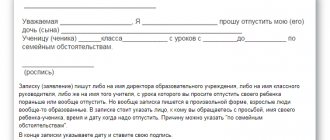Who is entitled to receive this deduction?
Who is eligible for the double child tax credit ? These categories of citizens include:
- Parents and adoptive parents of children:
- under the age of majority (the amount of the deduction is calculated based on the amount of 1,400 rubles for the first, the same for the second child, 3,000 for the third, the same for each subsequent child, 12,000 for a child with a disability);
- under the age of 24 years, with a disability of 1 or 2 groups and full-time students (the deduction is 12,000 rubles per child).
- Guardians of children who belong to the same categories as specified in paragraph 1 (but in cases where parents and adoptive parents can receive a deduction calculated based on the amount of 12,000 rubles, guardians receive compensation in the amount of 6,000 rubles).
All of the indicated amounts, on the basis of which the deduction in question is calculated, are established by law.
A prerequisite for receiving the compensation in question is the availability of income that is subject to personal income tax at a rate of 13% (for example, represented by wages under an employment contract). The corresponding deduction is provided by the state to a citizen only on account of the personal income tax paid or calculated on his income.
A taxpayer has the right to the corresponding standard deductions only if their annual income (the one on which personal income tax is paid) does not exceed 350,000 rubles. This amount is established by law. Starting from the month in which the citizen’s cumulative income exceeds the specified amount, the deduction cannot be provided until the end of the year.
According to the law, under certain conditions, each person has the right to receive deductions calculated on the basis of amounts twice as large as those indicated: in fact, this is the double tax deduction for a child .
Let's study how a taxpayer can exercise this right.
In what cases can you claim a deduction?
A partial refund is provided to the taxpayer in each reporting month for which tax has been paid. However, this type of assistance is available only if the total annual income does not exceed 350,000 rubles. In the event that a family receives a partial refund and one of the working parents has exceeded this figure, the refund is suspended.
So, in what amounts can you expect a refund of material resources:
- if a family is raising one or two children, 1,400 rubles are due;
- for the third and each subsequent 3,000 rubles are provided;
- if the family has a dependent child with a disability, schoolchild, student, graduate student or intern, but only up to the age of 24, 12,000 rubles are due. and guardians or trustees are additionally provided with 6,000 rubles.
In the case where a man and a woman marry, and there are children from the previous relationship, the child born in the next marriage will be considered the second or third, depending on the sequence.
Please note that the standard deduction for a disabled child is summed up with a deduction that depends on the type of child (first, second, etc.). What does this mean? For example, two parents have one disabled minor child. Accordingly, each parent is entitled to a deduction of 1,400 rubles for this child. as for the first child and as an additional deduction in the amount of 12,000 rubles. In total, one parent is entitled to a deduction for a month totaling 13,400 rubles. (the amount of cash deducted will be 13400×13%=1742 rubles). But again, do not forget about the established income limit of 350,000 rubles.
How to exercise the right to double the child deduction amount?
According to the law, the following are entitled to take advantage of the double standard deduction for a child:
- The only parent, adoptive parent, guardian - until he gets married.
If he registers a marriage, in the same month he loses the opportunity to use a double deduction (but at the same time retains the right to a standard deduction for children in the usual amount).
- The father or mother of the child if:
- the other parent will write to his employer a statement that he refuses to take the corresponding standard deduction for himself;
- the employer company, in turn, will provide a certificate stating that the standard deduction is not provided to the citizen.
A certificate from the employer must be submitted to the company where the parent works, applying for a double deduction for the child. This certificate must be prepared monthly.
In addition, one of the parents has the right to transfer to the other the right to the corresponding standard deduction only if he himself has a confirmed right to it. For example, if the mother of a child is on maternity leave, then during the maternity leave she will not have the right to receive this standard deduction (due to the lack of income that is subject to personal income tax). Accordingly, the right to deduction that the wife does not have cannot be used by the father of the child.
Let's now examine how taxpayers can exercise their rights to the double standard child deduction in practice.
To do this, they can use the following 2 mechanisms:
- registration of deductions from the employer company;
- receiving a deduction through the Federal Tax Service.
“Children’s” personal income tax deductions for single parents
Does the alimony payer have the right to be provided with standard tax deductions for child support (600 rubles) for personal income tax? The parent does not live with his minor child, but pays child support for his maintenance. Divorced. Is he entitled to a double standard tax deduction for child support (RUB 1,200)?
According to paragraphs 4 paragraphs 1 art. 218 Tax Code of the Russian Federation
When determining the size of the tax base for personal income tax, the taxpayer has the right to receive a standard tax deduction in the amount of
600 rubles
for each month of the tax period for:
– each child of taxpayers who support the child and who are parents or spouses of parents;
– each child of taxpayers who are guardians or trustees, adoptive parents.
A tax deduction is made for each child under the age of 18, as well as for each full-time student, graduate student, resident, student, cadet under the age of 24 from parents and (or) spouses of parents, guardians or trustees, adoptive parents.
The specified tax deduction is doubled
in the event that a child under the age of 18 is a disabled child, as well as in the event that a full-time student, graduate student, resident, student under the age of 24 is a disabled person of group I or II.
Widows (widowers), single parents
, guardians or trustees, adoptive parents, the tax deduction is double. The provision of the specified tax deduction to widows (widowers) and single parents ceases from the month following the month of their marriage.
Under single parents
Chapter 23 of the Tax Code of the Russian Federation means one of the parents who is not in a registered marriage.
In 2006, in a letter from the Ministry of Finance of the Russian Federation dated July 14, 2006 No. 03-05-01-04/213, noting that the tax deduction for a child (children) in the amount of 1200 rubles.
for each child for each month of the tax period can be provided only to one of the parents who is supporting the child (children), officials made the logical conclusion that, accordingly, the other parent (including those paying alimony for the maintenance of the child (children) ) has the right to a standard tax deduction
in the amount of 600 rubles.
for each child for each month of the tax period up to the month in which the income, calculated on an accrual basis from the beginning of the tax period, does not exceed 40,000 rubles.
However, already in 2007, officials announced that such single parents (not in a registered marriage), including those paying alimony
for the maintenance of a child (children) are not entitled to the standard tax deduction provided for
in paragraphs.
4 paragraphs 1 art. 218 of the Tax Code of the Russian Federation (letter of the Ministry of Finance of the Russian Federation dated 06/09/2007 No. 03-04-07-01/117).
In 2008, this position was confirmed.
Thus, in the opinion of the Ministry of Finance of the Russian Federation, set out in letter No. 03-04-06-01/119 dated May 6, 2008, single parents are provided with a tax deduction in double the amount so that its amount is not less than the total amount of this deduction provided to both parents who are in a registered marriage.
That is, a tax deduction of 1200 rubles. for each child for each month of the tax period can be provided only to one of the single parents who is supporting the child. Otherwise, divorced parents would have an unfair advantage over married parents.
The other parent (including those paying alimony for the maintenance of the child (children)) is not entitled to the standard tax deduction provided for in paragraphs 4 paragraphs 1 art. 218 Tax Code of the Russian Federation
.
It should be noted that Art. 218 Tax Code of the Russian Federation
connects the receipt of a tax deduction for a child directly with the fact that
provides for
the child.
At the same time, for the purposes of tax legislation, no special meaning of the term “security” has been established.
In accordance with paragraph 1 of Art. 11 Tax Code of the Russian Federation
institutions, concepts and terms of civil, family and other branches of legislation of the Russian Federation used in the Tax Code of the Russian Federation are applied in the meaning in which they are used in these branches of legislation, unless otherwise provided by the Tax Code of the Russian Federation.
Therefore, the concept of “providing for a child” for tax purposes should be used in the meaning established by family law.
Art. 80 of the Family Code of the Russian Federation
It is established that parents are obliged to support their minor children. The procedure and form for providing maintenance to minor children are determined by the parents independently.
Parents have the right to enter into a maintenance agreement
their minor children (agreement on payment
of alimony
).
If parents do not provide maintenance to their minor children, funds for the maintenance of minor children (alimony) are collected from the parents in court.
In the absence of an agreement between the parents on the payment of alimony, in the absence of provision of maintenance to minor children and in the failure to file a claim in court, the guardianship and trusteeship authority has the right to file a claim for the recovery of alimony for minor children against their parents (one of them).
That is, alimony
– these are funds for the maintenance (provision) of children.
And the parent paying child support is recognized as a supported
where the child is located.
Since a double deduction is provided to only one single parent, the second parent has every right to receive a tax deduction in the amount of 600 rubles.
The same position is shared by arbitration courts.
For example, the Federal Antimonopoly Service of the North-Western District in resolutions dated 03/04/2003 No. A05-10753/02-555/14 and dated 02/04/2005 No. A26-6025/04-29 indicated that if both parents are not married
, they are both recognized as single parents and, accordingly, are entitled to the standard double tax deduction for children, subject to participation in the maintenance of the child.
And the FAS Volga-Vyatka District, in resolution dated May 24, 2006 No. A82-18637/2005-37, recognized the right of a divorced father to receive a standard tax deduction in a single amount.
From January 1, 2009
the situation will change.
Federal Law of the Russian Federation dated July 22, 2008 No. 155-FZ in paragraphs. 4 paragraphs 1 art. 218 Tax Code of the Russian Federation
A new rule has been introduced according to which the “children’s” tax deduction can be provided in double amount to one of
the parents
(adoptive parents) of their choice based on
an application for refusal
of one of the parents (adoptive parents) to receive a tax deduction.
Obviously, in this way the officials decided to resolve a controversial situation when a child has two unmarried parents
.
Now, we repeat, each of these parents is formally recognized as single
and has the right to receive a “children’s” deduction in double amount.
From January 1, 2009
In order for one of the parents to receive a “children’s” deduction in double amount, the second parent will have to write a statement waiving the deduction.
all parents can take advantage of this provision and receive a double child deduction if the second parent refuses the deduction.
, both married and unmarried.
How to apply for a deduction through an employer
To solve the problem under consideration, a parent who has decided to take advantage of the right to a double deduction for a child and has this right needs:
- Provide to the financial department of your employer company:
- statement of desire to receive the corresponding deduction;
- birth certificate of the child for whom the deduction is issued;
- certificate from the educational organization (for children over 18 years old).
An application to the financial department can be drawn up in free form, but it still makes sense to check with accounting specialists about what form of document it is advisable to use, as well as what wording is appropriate in the application.
Download a sample application for a tax deduction for a child
- If the taxpayer is in a registered marriage, provide the accounting department with documents certifying the fact that the spouse waives the right to the corresponding standard deduction:
- a copy of the application to the spouse’s employer to waive the deduction;
- a certificate from this employer stating that the deduction is not paid to the spouse.
As we noted above, a certificate from another employer must be provided to the company in which one of the parents receives double compensation every month.
The taxpayer's application - as the main document for registering a deduction from the employer, can be submitted only once. However, if the taxpayer has another child and he acquires the right to calculate a deduction on the additional amount, the corresponding application will need to be completed again.
The situation is similar with a copy of the application from the other parent. In general, it will only be needed once, but if taxpayers have another child and want to increase the deduction amount, the corresponding document will need to be issued again. In turn, you will also need an updated certificate from another employer stating that the deduction in an increased amount is not paid to the taxpayer’s spouse.
As soon as the necessary documents are sent by the taxpayer to the accounting department, he begins to receive a salary, the personal income tax from which is reduced by 13% of the amount established for the deduction for a child.
The adult daughter of an employee of the organization (for the latter this organization is the place of main work) is studying at a higher educational institution, where she receives her first higher education as a full-time student. An employee of the organization is recognized as a single parent, since her daughter’s father died. In May 2021, she entered into a new marriage.
1. Did the employee still have the status of a single parent after her marriage?
Remained.
The list of persons falling under the category of single parents is determined by part five of subparagraph. 1.2 clause 1 art. 164 NK. It includes incl. such a category as a parent, if the child’s second parent has died or been deprived of parental rights.
A single parent has the right to receive a standard deduction in the amount of 52 rubles. per month (paragraph 1 of part five, subclause 1.2, clause 1, article 164 of the Tax Code), which is provided for each:
– a child under 18 years of age;
– a student over 18 years of age receiving full-time general secondary, special, first vocational, first secondary specialized, first higher education.
When a single parent gets married, the provision of a standard tax deduction in an increased amount ceases from the month following the month of adoption of the child (part six, subclause 1.2, clause 1, article 164 of the Tax Code).
However, in the above situation, the employee’s daughter is an adult and, according to national law, is not subject to adoption.
Consequently, the employee does not lose the status of a single parent in relation to her student daughter even after marriage.
2. Until what period does the organization have the right to apply a standard deduction in the amount of 52 rubles in relation to the income of the specified employee? per month?
Until the end of my daughter's education.
Since the employee’s daughter is a full-time student receiving her first higher education, the organization, when calculating income tax, has the right to apply the standard tax deduction established by subsection. 1.2 clause 1 art. 164 Tax Code in the amount of 52 rubles, until the end of my daughter’s education.
To receive this deduction the following must be presented:
– a copy of the death certificate of the child’s second parent (in this case, the father);
– a certificate (its copy) from an educational institution stating that the payer’s child over 18 years of age is (was) a student and is receiving (receiving) a full-time general secondary, special, first vocational, first secondary specialized or first higher education education.
The payer submits the certificate to the tax agent:
– as the rights to receive a deduction arise – before the first payment of income;
– in case of loss of the right to these deductions - no later than the month following the month of loss of such right (clause 6 of Article 164 of the Tax Code).
How to get a deduction through the Federal Tax Service
The following deduction scheme provides:
- Preparation by a citizen of documents:
- 2-NDFL certificate (it is ordered from the employer’s financial department);
- 3-NDFL declaration (filled out on your own or when asking for help from companies that provide services for filling out such declarations);
- child's birth certificate;
- certificates from the educational organization - if the child is an adult;
- application for payment of compensation (this document, unlike the free-form application in the first version of the deduction, must be filled out on an official form);
- if the taxpayer is married - a copy of the other parent’s statement to his employer about the desire to waive the right to receive the deduction in question.
- Transfer of the listed documents to tax authorities in the year following the one for which the 3-NDFL declaration, as well as the 2-NDFL certificate, were issued.
If the specified documents are drawn up correctly, then within 4 months the Federal Tax Service will transfer the tax deduction for the child in double the amount to the personal bank account of the parent, which is indicated in the application.
What specific amount can the deduction in question be provided in? What are the nuances of practical implementation by taxpayers of the corresponding privileges?
To answer these questions, let's study several examples with calculations for standard deductions in double amounts for children.
Double deduction amount: examples of calculations
Example 1: double deduction issued by the company that is the applicant’s employer.
Savelyev A.A. and Savelyeva V.A. four children.
From January 2021 Savelyev A.A. carries out labor activities at Soyuz-Plastik LLC. His monthly income is 40,000 rubles, while personal income tax is paid on it in the amount of 5,200 rubles. The employee receives 34,800 rubles. Savelyeva V.A. works at Soyuz-Polymer LLC and receives the same salary.
At the family council, the Savelyevs decided that the deduction would be processed by the father of the family. Savelyev A.A., thus, transfers to the accounting department of Soyuz-Plastic LLC:
- application in the form issued by the chief accountant of Soyuz-Plastic LLC;
- birth certificates of each child;
- Statement by Savelyeva V.A. for the accounting department of Soyuz-Polymer LLC about its refusal of the right to use its own standard deduction for children;
- a certificate from Soyuz-Polymer LLC stating that Savelyeva V.A. does not receive the corresponding deduction at this enterprise.
If Savelyev A.A. If I filed a deduction in the usual amount, not in double value, then I would receive every month legally:
- a deduction of 13% - 182 rubles, from the amount determined by law for the first child - 1400 rubles, similarly - for the second child;
- a deduction, which is 13% - 390 rubles, from the amount determined by law for the third child - 3000 rubles, the same amount - for the fourth child.
In total, the head of the Savelyev family would receive 1,144 rubles monthly in the form of compensation in question. The personal income tax calculated from his monthly salary would be reduced by this amount (accordingly, the amount given by the employer to A.A. Savelyev would increase).
But since Savelyeva V.A. in accordance with the procedure established by law, refused to receive a similar deduction, Savelyev A.A. will be able to issue this deduction in double size. That is, the total personal income tax from his salary will be reduced by 2,288 rubles.
An important condition for this is the monthly provision of a certificate from Soyuz-Polymer LLC stating that Savelyeva V.A. does not receive the appropriate standard tax deduction from the employer.
Example 2: double deduction issued by the Federal Tax Service.
The Savelyevs we know decided that the father of the family would receive the double deduction in question not through the employer company, but through the Federal Tax Service. To the Tax Inspectorate Savelyev A.A. were thus provided:
- certificate 2-NDFL issued by the accounting department of Soyuz-Plastic LLC;
- Declaration 3-NDFL, filled out by Savelyev A.A. on one's own;
- children's birth certificates;
- copy of the application of Savelyeva V.A. to the accounting department of Soyuz-Polymer LLC about the desire to refuse to receive a deduction;
- an application issued by Federal Tax Service specialists when accepting documents.
As we already know, the double standard deduction of Savelyev A.A. for four children, when applying for compensation from the employer, it is 2,288 rubles per month. When applying to the Federal Tax Service, the deduction is calculated for all months of the year during which the applicant carried out labor activities. That is, in this case, the compensation will be 27,456 rubles (2288 * 12).
Double deductions for children: nuances
When applying for double deductions for children, it will be useful for the taxpayer to pay attention to a number of important nuances:
- If the taxpayer has the right to other standard deductions - for example, those established for participants in overcoming the consequences of the accident at the Chernobyl nuclear power plant, then he has the right to fully use them simultaneously with the compensation in question.
In turn, if a person has issued a standard deduction not for children, but on another basis - for example, as a participant in armed conflicts, then he will only have the right to use it. This deduction can be replaced by another standard one - the largest in terms of the amount of personal income tax returned or in terms of reducing the calculated personal income tax from wages.
- If a parent works in several companies, then he can apply for compensation to any of them - of his choice. If necessary, you can take into account income in the form of salaries in each of the relevant companies.
However, when filing a deduction with the Federal Tax Service, you will need to request a 2-NDFL certificate from the accounting departments of each organization confirming the taxpayer’s income. But in any case, the 3-NDFL declaration is prepared alone.
- If a parent worked in one company at the beginning of the year, then quit it, moved to another company and draws up the deduction in question there, for the purpose of calculating the deduction, income received from the previous employer must be used. They are certified by a certificate issued by the accounting department of the employer.
- If necessary, the taxpayer can place 2 schemes for obtaining deductions that we have considered - through the employer and through the Federal Tax Service.
For example, if from January to September 2021 he did not receive appropriate compensation from his employer (alternatively, due to the fact that he did not have time to complete the necessary documents, but received only from October to December), then in 2021 the taxpayer will has the right to apply for a deduction from income from January to September 2021 by contacting the Federal Tax Service.






